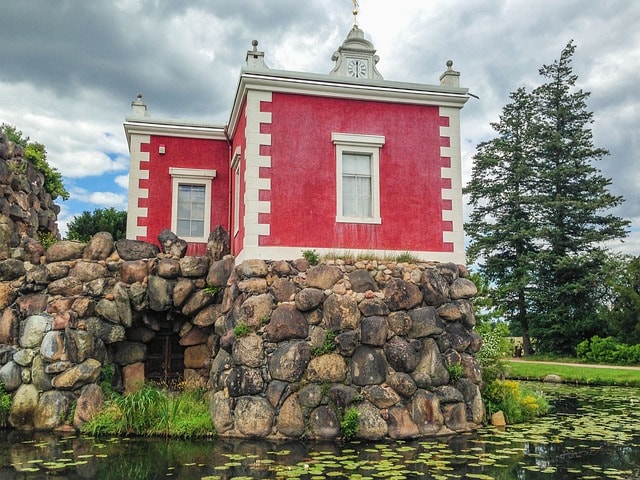Planning a trip to Anhalt, Germany? Located in Saxony-Anhalt, this region is rich in medieval history, stunning Bauhaus architecture, and natural wonders like the Elbe River and Harz Mountains. Discover its unique attractions, cultural heritage, and travel tips in our comprehensive guide.
Table of Contents
Key Takeaways
Saxony-Anhalt, known for its historical background, evolved from the Principality of Anhalt in the 13th century, playing a significant role in the Holy Roman Empire and contributing to modern German culture.
The region features diverse geography with major attractions like the Elbe River and the Harz Mountains, which provide recreational opportunities and showcase its natural beauty.
Saxony-Anhalt’s rich cultural heritage includes influential figures like Martin Luther, the Bauhaus movement, and various traditional festivals, enhancing its appeal as a tourist destination.
Historical Background of Anhalt

Saxony-Anhalt, known for its major cities like the capital Magdeburg, Halle, and Dessau-Roßlau, is a land steeped in history. The origins of Anhalt trace back to its formation as a medieval principality in the 13th century, which played a significant role in the Holy Roman Empire. Over the centuries, the state of Saxony-Anhalt evolved, contributing to the political and cultural landscape of what is now modern-day german states.
The journey of Anhalt through the German Empire, Weimar Republic, and Nazi Era showcases its resilience and adaptability. From its agricultural and industrial prowess to its cultural contributions, Anhalt has been a cornerstone in the broader narrative of German history.
The Principality of Anhalt
The formation of the Principality of Anhalt in the 13th century was a pivotal moment in the region’s history. This principality significantly influenced the political landscape of the Holy Roman Empire, with Dessau emerging as the capital of the Duchy of Anhalt. The principality’s strategic location and political alliances helped shape its development and prominence within the empire.
Anhalt in the German Empire
During the German Empire’s unification in 1871, Anhalt became a crucial geographical center among the german federal states. Its position facilitated transportation and communication, making it an integral part of the empire’s infrastructure. Anhalt’s economy thrived on agriculture and industry, with the Elbe River serving as a vital waterway for trade and freight movement.
This period marked significant growth and development for the region.
Anhalt in the Weimar Republic and Nazi Era
The Weimar Republic era was a time of political instability for Anhalt, setting the stage for the rise of extremist parties like the NSDAP. The Bauhaus movement, which had established a significant cultural institution in Dessau, faced suppression under the Nazi regime.
Despite these challenges, Anhalt’s contributions to art and architecture through the Bauhaus legacy remain a testament to its enduring cultural impact.
Geography and Natural Attractions
Saxony-Anhalt’s geographical diversity is one of its most captivating features. Situated primarily within the North European Plain, the region’s landscape has been shaped by historical glaciation. From the plains and hills to the rivers that traverse the land, Saxony-Anhalt offers a rich tapestry of natural beauty.
The Elbe River and the Harz Mountains are two of the region’s most notable natural attractions. The Elbe River runs through the northern and eastern parts of Saxony-Anhalt, providing picturesque views and various recreational opportunities. Meanwhile, the Harz Mountains, located in the southern part of the region, offer a contrasting landscape of rugged terrain and lush forests.
The Elbe River
The Elbe River is a lifeline for Saxony-Anhalt, offering stunning landscapes and a plethora of recreational activities. From boating and fishing to scenic walks along its banks, the Elbe River is a haven for nature enthusiasts.
Its significance extends beyond beauty, serving as a crucial waterway for trade and connecting inland areas to the North Sea.
The Harz Mountains
The Harz Mountains, home to the highest peak, Brocken, provide a playground for outdoor adventurers. Visitors can indulge in hiking, mountain biking, and even train rides through this picturesque terrain.
The Harz Mountains’ unique weather and breathtaking vistas make it a must-visit destination for those exploring Saxony-Anhalt.
Cultural Heritage and Traditions

Saxony-Anhalt’s cultural heritage is a mosaic of historical influences and traditions. The region boasts a rich tapestry of historical sites, including castles, gardens, and UNESCO World Heritage Sites. The Thirty Years’ War, religious reforms, and the Bauhaus movement have all left indelible marks on its cultural landscape.
Key figures like Martin Luther and institutions like Bauhaus Dessau have significantly influenced the region’s cultural identity. Traditional festivals further celebrate Saxony-Anhalt’s heritage, drawing visitors from around the world to partake in these vibrant events.
Martin Luther and the Protestant Reformation
Martin Luther, the father of the Protestant Reformation, was born in Eisleben, now part of Saxony-Anhalt. His teachings and theological disputes profoundly shaped the religious landscape of the region.
The legacy of Martin Luther is commemorated through various Luther memorials, underscoring Saxony-Anhalt’s historical significance in the Reformation.
Bauhaus Dessau
The Bauhaus movement, established by Walter Gropius, brought revolutionary changes to art and architecture. Bauhaus Dessau, founded in 1925, became a beacon of modernist design, emphasizing functionality and simplicity.
The Bauhaus buildings in Dessau are now UNESCO World Heritage Sites, attracting architecture enthusiasts from around the globe.
Traditional Festivals
Traditional festivals in Saxony-Anhalt, such as the Handel Festival in Halle and the Kurt Weill Festival in Dessau, celebrate the region’s rich cultural heritage. These festivals honor the contributions of renowned composers and draw numerous visitors each year. They play a crucial role in promoting Saxony-Anhalt tourism and preserving its cultural identity.
Major Cities and Towns
Saxony-Anhalt is home to several major cities and notable towns, each with its unique charm and historical significance. Dessau-Roßlau, Köthen, and Bernburg are among the key destinations that highlight the region’s rich cultural and architectural heritage.
These cities are well-connected by train and public transport, making it easy for visitors to explore the diverse attractions Saxony-Anhalt has to offer. The Marego and MDV transport associations provide comprehensive public transport options, including local trains, trams, and buses.
Dessau-Roßlau
Dessau-Roßlau stands out with its two UNESCO World Heritage Sites, including the Bauhaus buildings. Visitors can explore the original Bauhaus campus, museum, and iconic houses, immersing themselves in the legacy of modernist architecture.
For a unique experience, tourists can even stay overnight in the Bauhaus building, adding a historical touch to their visit.
Köthen
Köthen is renowned for its historical castle, which showcases Renaissance architecture and dates back to the 16th century. The town is also closely linked to the musical heritage of Johann Sebastian Bach, who served as Kapellmeister here.
Köthen’s historical sites and cultural significance make it a must-visit destination in Saxony-Anhalt.
Bernburg
Bernburg is a treasure trove of medieval heritage, featuring impressive castles and museums. The Bernburg Castle, overlooking the Saale River, has served as a fortress and residence throughout history.
The town’s medieval structures and rich history offer a captivating journey into the past for visitors.
Notable Sights and Landmarks

Saxony-Anhalt is a region rich in historical and cultural landmarks. With five UNESCO World Heritage Sites, the state boasts a wealth of historical treasures that draw visitors from all over the world. From medieval towns to ancient observatories, Saxony-Anhalt offers a diverse array of sights to explore.
The Dessau-Wörlitz Garden Kingdom, Quedlinburg, and the Goseck Circle are among the most notable landmarks that showcase the region’s historical depth and architectural beauty.
Dessau-Wörlitz Garden Kingdom
The Dessau-Wörlitz Garden Kingdom is one of Saxony-Anhalt’s UNESCO World Heritage Sites, designed by Prince Leopold III and Friedrich Franz of Anhalt Dessau. Spanning 112 hectares, this vast park blends nature with architecture, epitomizing the ideals of the Enlightenment.
Its formal landscaping and picturesque gardens make it a serene escape for visitors.
Quedlinburg
Quedlinburg is celebrated as the best-preserved medieval town in Germany, with over 1,300 timber-framed buildings dating back to the 10th and 12th centuries. The town’s cobblestone alleys and market squares transport visitors back in time, earning it a place on the UNESCO World Heritage list.
Quedlinburg’s architectural and historical significance make it a key cultural landmark in Saxony-Anhalt.
Goseck Circle
The Goseck Circle, dating back over 7,000 years, is one of the earliest known solar observatories in Europe. This Neolithic structure provides a fascinating glimpse into the advanced astronomical knowledge of prehistoric communities.
Its historical significance and mysterious origins make the Goseck Circle a remarkable sight to behold.
Learn more, visit The Middle Neolithic circular enclosure at Goseck.
Local Cuisine and Specialties
Saxony-Anhalt’s culinary landscape is a reflection of its rich cultural heritage. From hearty dishes to intricate desserts, the region’s cuisine offers a delightful journey for the taste buds. Milbenkäse, a unique cheese made from quark and flavored with caraway and salt, is one of the region’s specialties.
Traditional dishes and desserts play a significant role in local celebrations, highlighting the region’s culinary traditions and cultural identity.
Regional Dishes
Anhalt’s regional dishes are a testament to its culinary heritage. Altmärker Hochzeitssuppe, a traditional wedding soup with asparagus and small meatballs, showcases the region’s love for hearty soups.
Halberstädter Würstchen, known for their unique smoking process, and Bötel, Lehm und Stroh, a pork knuckle dish, are must-try specialties for visitors.
Desserts and Sweets
The Salzwedeler Baumkuchen, known as the ‘King of Cakes,’ is a traditional dessert that has been cherished for over 200 years. This intricate, layered cake, baked around a wooden roller, represents the region’s sweet culinary tradition.
The appreciation for Baumkuchen and other desserts highlights Anhalt’s enduring love for sweet treats.
Travel Tips for Visiting Anhalt
Planning a trip to Saxony-Anhalt involves considering the best time to visit, transportation options, and accommodation choices. The region offers a variety of experiences, from cultural festivals to natural explorations, ensuring a memorable visit. Visitors can enjoy Saxony-Anhalt’s beauty year-round, with each season offering unique attractions and events.
Best Time to Visit
The best time to visit Saxony-Anhalt is during the spring (April to June) and fall (September to October), when the weather is pleasant and the landscape is at its most beautiful. The summer months, particularly July, attract the highest concentration of visitors due to the warm weather and numerous local events.
For those looking to avoid crowds, September offers warm weather with fewer tourists, making it an ideal time for travel. Winter, especially December, is also a festive time to visit, with Christmas markets adding a magical touch to the region.
Transportation Options
Saxony-Anhalt is well-connected by train, offering convenient access to major cities and towns. Public buses provide services to smaller towns and rural areas, ensuring comprehensive coverage of the region.
For those who prefer more flexibility, car rentals are a popular option, allowing travelers to explore scenic routes and remote attractions at their own pace. Whether using public transport or renting a car, visitors have multiple options to discover the beauty and history of Saxony-Anhalt.
Accommodation
Anhalt offers a variety of lodging options to suit different preferences and budgets. From luxurious hotels like the Maritim Hotel in Dessau to charming guesthouses and budget-friendly hostels, there is something for everyone. Many accommodations are conveniently located near major attractions and public transportation, making it easy for visitors to explore the region.
Travelers are encouraged to consider these diverse options when planning their stay in Saxony-Anhalt.
Summary
Saxony-Anhalt is a region that seamlessly blends historical depth, cultural richness, and natural beauty. From the medieval charm of Quedlinburg to the revolutionary designs of Bauhaus Dessau, and from the scenic Elbe River to the rugged Harz Mountains, the region offers a diverse array of experiences. Its culinary delights and vibrant festivals further enhance the travel experience, making Saxony-Anhalt a must-visit destination. Whether you are a history enthusiast, a nature lover, or a culture aficionado, Saxony-Anhalt promises an unforgettable journey through time and tradition.
Frequently Asked Questions
What are the best times to visit Saxony-Anhalt?
The ideal times to visit Saxony-Anhalt are during the spring months of April to June and in the fall from September to October. Visiting in September is particularly favorable due to its warm weather and reduced tourist crowds.
What are some must-see landmarks in Saxony-Anhalt?
Some must-see landmarks in Saxony-Anhalt are the UNESCO World Heritage Sites, including the Dessau-Wörlitz Garden Kingdom, Quedlinburg, and the Goseck Circle. These sites offer significant historical and cultural value worth exploring.
What transportation options are available in Saxony-Anhalt?
Saxony-Anhalt offers various transportation options, including trains, public buses, and car rentals, ensuring convenient travel throughout the region. This well-connected network facilitates easy exploration for visitors.
What traditional dishes should I try in Saxony-Anhalt?
You should definitely try Altmärker Hochzeitssuppe, Halberstädter Würstchen, and Bötel, Lehm und Stroh, as well as the Salzwedeler Baumkuchen for dessert. These dishes encapsulate the culinary heritage of Saxony-Anhalt.
What festivals are celebrated in Saxony-Anhalt?
Saxony-Anhalt celebrates notable festivals such as the Handel Festival in Halle and the Kurt Weill Festival in Dessau, which highlight its rich musical heritage. These events draw attention to the region’s cultural significance.









